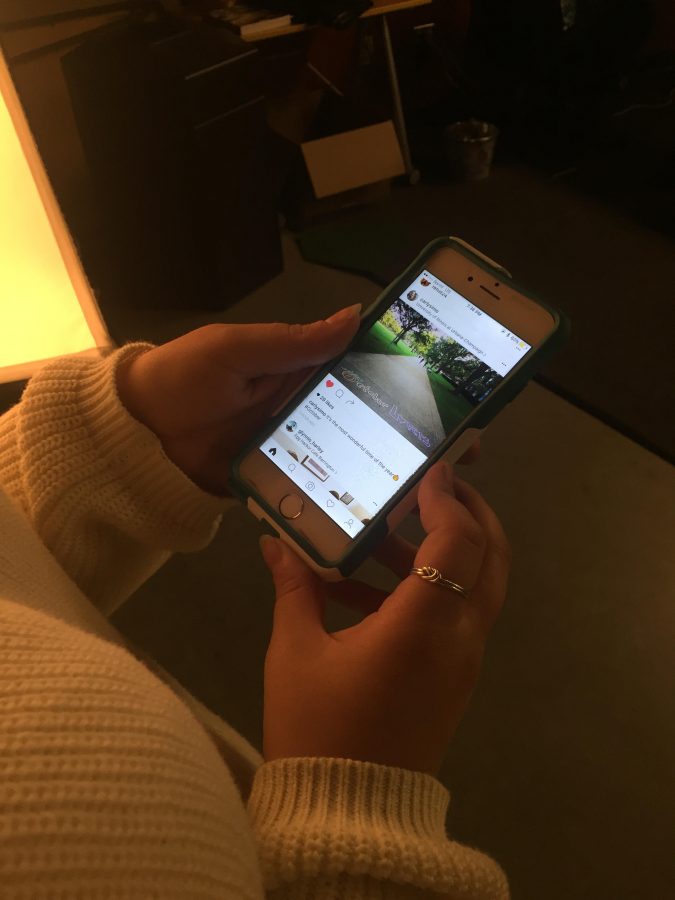Why college students love fake Instagram accounts
While some students are just casual Instagram users, others take it a step further.
Oct 2, 2016

A scroll through a typical University of Illinois user’s Instagram feed is likely to reveal images of attractive drunken girls at Kams, a perfectly prepared doughnut box from Pandamonium or a “candid” laughing picture taken in a barn — all captured in perfect light and enhanced with multiple photo editing apps.
Parties become never-ending photo shoots, and walks to class become judgmental scrolling sessions through fetishized, envy-evoking posts.
Instagram is one of the most popular social media outlets for college age students. A 2015 Pew Research survey found that 55 percent of online adults ages 18 to 29 use Instagram. More than a year later, one can only imagine these statistics have only risen.
But life isn’t all 45-degree-angle selfies, and “edgy” landscape pictures. Some college students are sick of trying to live up to their annoyingly curated Instagram feed and have created “finstagrams,” or fake Instagram accounts.
Get The Daily Illini in your inbox!
These finstas (Instagram shortens to Insta, therefore finstagram shortens to finsta) are usually set to private, meaning you must approve the users who can follow you and see your posts. Also, followers are mostly kept in the low double digits on purpose, so that the poster can feel comfortable posting more personal things to their better friends.
Common finsta posts can range from unattractive pictures to inappropriate pictures, and the captions are usually longer and more telling.
Sophie Morris, a sophomore in AHS, said, “I just post funnier pictures and kind of more like complaining pictures to share with just some of my friends compared to everyone that follows me.”
Principles that guide Instagram — such as posting no more than once a day — are completely disregarded on a finstagram, which makes the account both more frequently updated and more realistic to one’s life.
In a survey conducted by the Girl Scouts in 2010, 74 percent of girls agreed that other girls try to make themselves look “cooler than they really are” on social networking sites, and 41 percent admitted that this describes them.
Whereas most people won’t post a picture of them studying with acne cream all over their face in their dorm room on a normal Instagram account, people do this much more often on their finstas.
When people are immersed in a culture obsessed with creating an amazingly aesthetic online profile, it only makes sense that they’re looking for an outlet to truly be who they are and that person doesn’t always wake up #flawless without using their VSCO CAM app etc.
You may be thinking, “Just stop all of this nonsense and be yourself on your real Instagram, or get rid of Instagram all together.” For some that is an option; however, for many young people, social media has become a burdensome part of life that simply must be managed.
While young people of every generation struggle with how to project their identities onto the greater world, I argue that our generation has it the worst.
Lots of people think that the finsta culture is odd, as we have other applications that we can share photos on with only our friends. Take Snapchat for instance, where you can send individual friends photos that disappear in 10 seconds or fewer upon being opened.
The difference is that a finstagram can provide a concrete history of funny things to scroll though, whereas Snapchat is temporary. Additionally, Snapchat doesn’t allow for as much text as an Instagram caption does.
“I just like to have all my photos in one place,” said Ava Heemsoth, sophomore in Media.
Ava said she had around 560 followers on her real Instagram and merely 39 on her finstagram.
It makes sense that people allow so many less followers on their finstagrams. A Pace University study found a link between the numbers of strangers that Instagram users follow and the possibility that they experience depressive symptoms, such as fearfulness, loneliness or fatigue.
The paradox is that the finstagram is becoming the “real” Instagram; the filtered realities we see on people’s “real” Instagram accounts are incredibly cultivated while the “fake” accounts are ironically places for authenticity. The words “real” and “fake” here are curiously inverted and it is to help disguise the fact that we put different effort and emotion into posting our photos online.
Sadly, these platforms are going nowhere and we won’t get anywhere by trying to fight them. But I do believe there is a way to build more agencies around how we interact with them and then use this to our advantage.
Currently the #finstagram hashtag has over 27,000 entries on the social media app, and this isn’t including the general amount of people who do not use this hashtag in their posts.
The trend isn’t slowing down anytime soon, and maybe this isn’t a bad thing, in any case we are growing to become more comfortable showing our true colors to an online community even if it is our 39 closest friends. One day, we may combine our finstagrams and Instagrams, because everyone has days when their eyebrows are on “fleek” and days when they throw up in their 9 a.m. lecture.
Until then, just remember that what you see on a peers flawless Instagram isn’t all there is, and that likely that girl who has 3,000 followers also posts double chins to her smaller following on her finsta.
Leah is a sophomore in Media and Art and Design.






